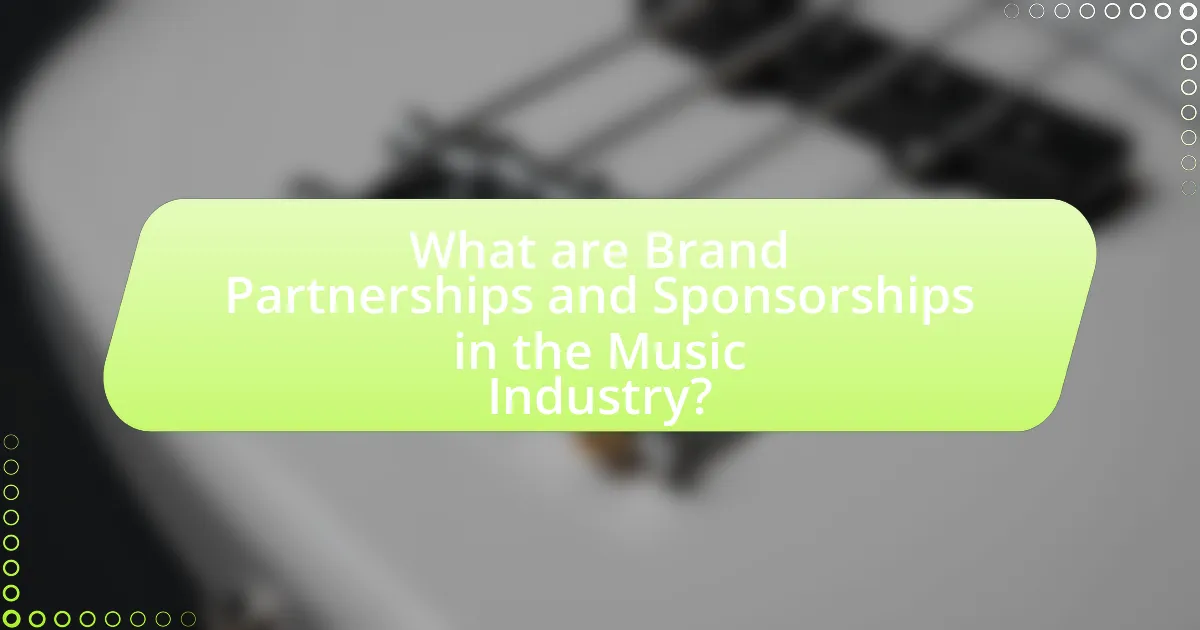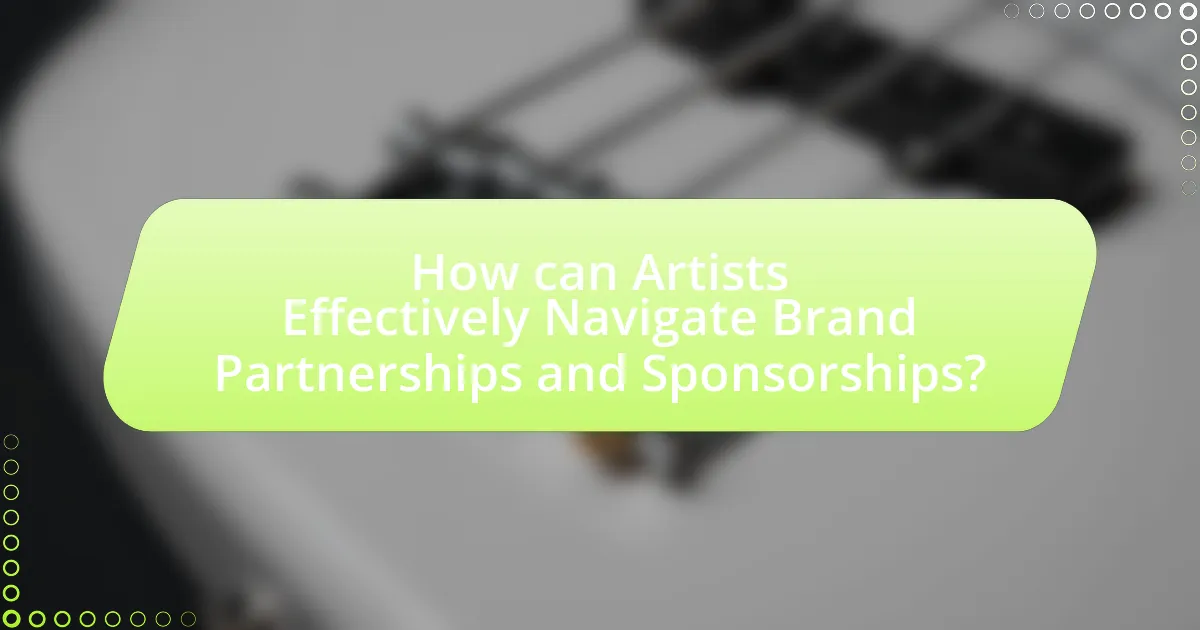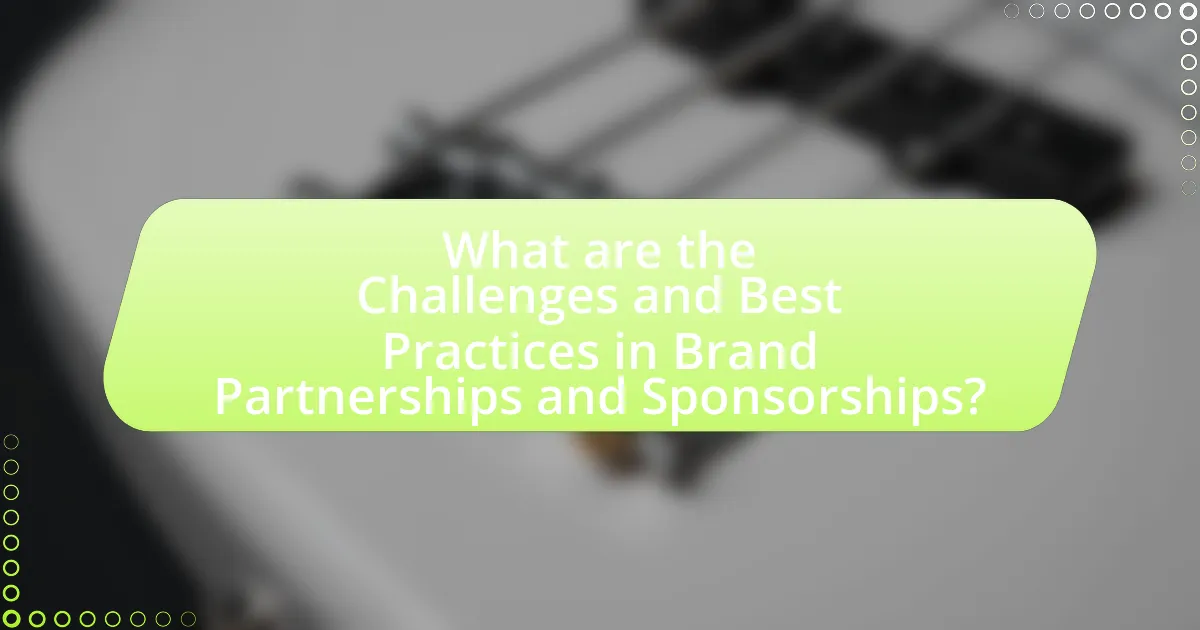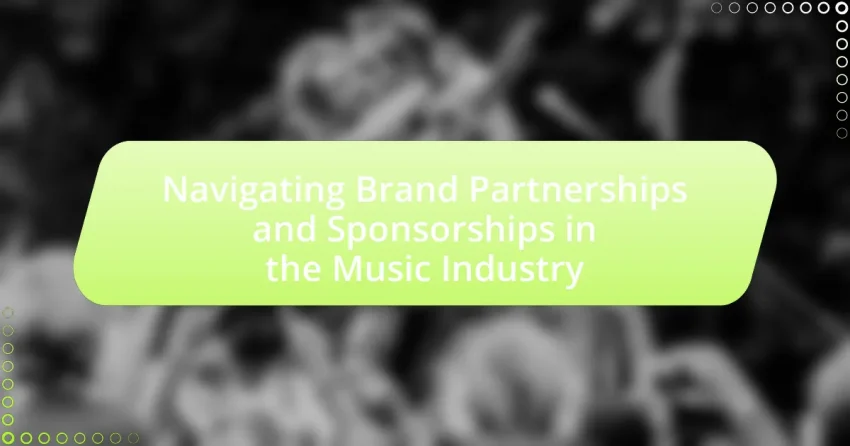Brand partnerships and sponsorships in the music industry are collaborative agreements between brands and music entities, such as artists and festivals, aimed at mutual benefits like financial support and promotional resources. The article explores the distinctions between brand partnerships and sponsorships, highlighting key characteristics, types, and the importance of these collaborations in enhancing artist visibility and revenue generation. It also addresses the challenges artists face in navigating these partnerships, best practices for successful collaborations, and strategies for maintaining authenticity while aligning with brand values. Additionally, the article provides insights into effective communication and metrics for measuring partnership success, offering practical tips for artists to maximize their brand collaborations.

What are Brand Partnerships and Sponsorships in the Music Industry?
Brand partnerships and sponsorships in the music industry refer to collaborative agreements between brands and music entities, such as artists, festivals, or record labels, aimed at mutual benefit. These partnerships often involve financial support or promotional resources from brands in exchange for visibility and association with the music entity, enhancing brand image and reaching target audiences. For instance, major brands like Coca-Cola and Red Bull have historically sponsored music festivals, providing funding and marketing in return for brand exposure to large audiences, demonstrating the effectiveness of such collaborations in driving consumer engagement and brand loyalty.
How do Brand Partnerships differ from Sponsorships?
Brand partnerships involve a collaborative relationship between two or more brands that work together to achieve mutual goals, often sharing resources and co-creating products or marketing campaigns. In contrast, sponsorships typically involve one brand providing financial support or resources to an event, individual, or organization in exchange for promotional benefits, such as brand visibility. For example, a brand partnership may result in a co-branded album or concert series, while a sponsorship might involve a brand sponsoring a music festival to gain exposure to its audience.
What are the key characteristics of Brand Partnerships?
Brand partnerships are collaborative agreements between two or more brands that leverage each other’s strengths to achieve mutual marketing goals. Key characteristics include shared values and target audiences, which ensure alignment in messaging and brand identity; complementary products or services that enhance customer experience; and strategic objectives that focus on increasing brand awareness, driving sales, or entering new markets. Additionally, successful brand partnerships often involve co-creation of content or experiences, allowing for innovative marketing strategies that engage consumers effectively. These partnerships can lead to increased credibility and reach, as evidenced by successful collaborations in the music industry, where brands align with artists to tap into their fan bases and enhance brand visibility.
What defines a Sponsorship in the music context?
A sponsorship in the music context is defined as a financial or in-kind support provided by a brand or company to a music artist, event, or organization in exchange for promotional opportunities. This relationship typically involves the brand gaining visibility through logos on promotional materials, mentions in marketing campaigns, or exclusive access to events, while the artist or event receives funding or resources to enhance their offerings. For instance, major brands like Red Bull and Coca-Cola have historically sponsored music festivals and artists, demonstrating the mutual benefits of increased exposure and financial backing in the music industry.
Why are Brand Partnerships and Sponsorships important in the Music Industry?
Brand partnerships and sponsorships are crucial in the music industry because they provide essential funding and resources that support artists and events. These collaborations enable musicians to reach wider audiences through brand exposure, enhancing their visibility and marketability. For instance, a study by Nielsen Music found that 70% of concertgoers are more likely to attend an event if it is sponsored by a brand they recognize, demonstrating the direct impact of sponsorship on audience engagement. Additionally, partnerships often lead to innovative marketing strategies, such as exclusive content or experiences, which can significantly boost an artist’s revenue and fan loyalty.
How do they enhance artist visibility and reach?
Brand partnerships and sponsorships enhance artist visibility and reach by leveraging the established audiences and marketing resources of brands. These collaborations allow artists to access new demographics, as brands often have extensive marketing channels, including social media, advertising, and events, which can amplify the artist’s exposure. For instance, a partnership with a well-known beverage company can place an artist’s music in commercials, social media campaigns, and live events, significantly increasing their audience engagement. According to a study by Nielsen, 70% of consumers feel more connected to brands that partner with artists, indicating that such collaborations can effectively enhance an artist’s visibility and broaden their reach in the market.
What role do they play in revenue generation for artists?
Brand partnerships and sponsorships play a crucial role in revenue generation for artists by providing additional income streams beyond traditional music sales and performances. These collaborations allow artists to leverage their brand equity, reaching wider audiences through co-marketing efforts, which can lead to increased merchandise sales, ticket sales, and overall visibility. For instance, a study by Nielsen Music found that 70% of music fans are more likely to purchase products endorsed by their favorite artists, demonstrating the financial impact of effective brand partnerships.
What are the common types of Brand Partnerships and Sponsorships in Music?
Common types of brand partnerships and sponsorships in music include event sponsorships, artist endorsements, and co-branded content. Event sponsorships involve brands financially supporting music festivals or concerts, enhancing visibility and engagement with audiences. Artist endorsements occur when musicians promote a brand’s products or services, leveraging their influence to reach fans. Co-branded content involves collaborations between brands and artists to create unique music-related experiences or products, such as exclusive tracks or merchandise. These partnerships are prevalent as they provide mutual benefits, including increased brand exposure and enhanced artist revenue.
What are the different models of Brand Partnerships?
The different models of Brand Partnerships include co-branding, sponsorship, licensing, and affiliate marketing. Co-branding involves two brands collaborating to create a product that features both brand identities, enhancing visibility and market reach. Sponsorship entails a brand financially supporting an event or entity in exchange for promotional opportunities, often seen in music festivals and concerts. Licensing allows one brand to use another’s intellectual property, such as logos or music, for a fee, which can generate revenue for both parties. Affiliate marketing involves brands partnering with influencers or affiliates who promote their products, earning a commission on sales generated through their referrals. Each model serves distinct strategic purposes in enhancing brand visibility and engagement within the music industry.
How do Sponsorships manifest in live events and tours?
Sponsorships in live events and tours manifest primarily through financial support, branding opportunities, and promotional activities. Brands provide funding to artists or event organizers in exchange for visibility, which can include logo placement on promotional materials, merchandise, and stage backdrops. For instance, major festivals often feature sponsors prominently in their marketing campaigns, enhancing brand recognition among attendees. Additionally, sponsors may engage in experiential marketing by setting up booths or interactive experiences at events, allowing them to connect directly with the audience. According to a report by IEG, sponsorship spending in the U.S. reached $24 billion in 2021, highlighting the significant role sponsorships play in the live event landscape.

How can Artists Effectively Navigate Brand Partnerships and Sponsorships?
Artists can effectively navigate brand partnerships and sponsorships by aligning their personal brand with the values and target audience of potential sponsors. This alignment ensures that collaborations resonate authentically with both the artist’s fan base and the brand’s market, leading to successful partnerships. For instance, artists like Billie Eilish have partnered with brands such as Nike, which share a commitment to sustainability, enhancing both their brand images and audience engagement. Additionally, artists should conduct thorough research on brands to understand their reputation and past partnerships, ensuring compatibility and avoiding potential backlash. By leveraging social media analytics, artists can also gauge audience sentiment and engagement levels, which can inform their partnership decisions.
What strategies should artists employ to attract brand partnerships?
Artists should employ targeted marketing strategies, such as leveraging social media platforms and building a strong personal brand, to attract brand partnerships. By actively engaging with their audience on platforms like Instagram and TikTok, artists can showcase their unique style and values, making them more appealing to brands seeking authentic representation. Additionally, collaborating with other artists or influencers can expand their reach and visibility, further attracting potential brand partnerships. Research indicates that 70% of consumers are more likely to buy from brands that partner with influencers they trust, highlighting the importance of authenticity in these collaborations.
How can artists identify suitable brands for collaboration?
Artists can identify suitable brands for collaboration by analyzing brand values, target audiences, and previous partnerships. By researching brands that align with their artistic vision and demographic, artists can ensure a mutually beneficial relationship. For instance, a musician focused on sustainability may seek partnerships with eco-friendly brands, as evidenced by collaborations like Billie Eilish with Reverb, which promotes environmental awareness. Additionally, artists can utilize social media analytics to gauge brand engagement and audience overlap, further validating their choices.
What factors should artists consider when negotiating terms?
Artists should consider the scope of the partnership, including deliverables, timelines, and exclusivity clauses when negotiating terms. These factors directly impact the artist’s creative freedom, financial compensation, and future opportunities. For instance, understanding the expected deliverables ensures that artists can align their artistic vision with brand expectations, while timelines dictate the feasibility of fulfilling those commitments. Additionally, exclusivity clauses can limit an artist’s ability to work with competing brands, which may affect their overall marketability and income potential. Therefore, careful consideration of these elements is crucial for artists to secure favorable terms that protect their interests and enhance their career trajectory.
How can artists maintain authenticity while partnering with brands?
Artists can maintain authenticity while partnering with brands by ensuring that their collaborations align with their personal values and artistic vision. This alignment fosters genuine connections with their audience, as fans are more likely to support partnerships that reflect the artist’s true identity. For instance, artists like Billie Eilish have successfully collaborated with brands such as Nike, emphasizing sustainability, which resonates with her environmental advocacy. This strategic choice not only enhances brand credibility but also reinforces the artist’s commitment to authenticity, as evidenced by her fan engagement and loyalty.
What are the risks of compromising artistic integrity?
Compromising artistic integrity can lead to a loss of authenticity and credibility for artists. When musicians prioritize commercial interests over their creative vision, they risk alienating their core audience, which can result in decreased fan loyalty and engagement. For instance, a study by the University of Southern California found that artists who maintain their artistic integrity tend to have more sustainable careers and stronger connections with their audience. Additionally, compromising artistic integrity may lead to a homogenization of music, reducing diversity and innovation within the industry. This can ultimately diminish the overall cultural value of music as a form of expression.
How can artists ensure alignment with brand values?
Artists can ensure alignment with brand values by conducting thorough research on the brand’s mission, vision, and core values before entering any partnership. This involves analyzing the brand’s previous campaigns, public statements, and social media presence to identify key themes and messages that resonate with their audience. For instance, a study by the Harvard Business Review found that brands with clear values attract consumers who share similar beliefs, leading to stronger partnerships. By aligning their artistic vision and messaging with the brand’s values, artists can create authentic collaborations that enhance both their image and the brand’s reputation.

What are the Challenges and Best Practices in Brand Partnerships and Sponsorships?
Challenges in brand partnerships and sponsorships include misalignment of brand values, lack of clear communication, and difficulty in measuring return on investment (ROI). Misalignment occurs when the partnering brands do not share similar target audiences or values, leading to ineffective campaigns. Clear communication is essential; without it, expectations may not be met, resulting in dissatisfaction for both parties. Measuring ROI can be challenging due to the subjective nature of brand perception and the various metrics involved.
Best practices involve establishing shared goals, maintaining open lines of communication, and utilizing data analytics to assess campaign effectiveness. Establishing shared goals ensures that both brands are aligned in their objectives, which enhances collaboration. Open communication fosters trust and allows for adjustments during the partnership. Utilizing data analytics helps in quantifying the success of the partnership, providing insights that can guide future collaborations. According to a study by the Association of National Advertisers, 70% of marketers believe that partnerships are essential for brand growth, highlighting the importance of effective strategies in this area.
What common challenges do artists face in brand partnerships?
Artists commonly face challenges in brand partnerships, including misalignment of values, lack of creative control, and contractual complexities. Misalignment occurs when the brand’s image does not resonate with the artist’s identity, potentially alienating their fan base. Lack of creative control can hinder artists from expressing their authentic voice, as brands may impose restrictions on content. Contractual complexities often lead to misunderstandings regarding deliverables, compensation, and rights, which can create friction between artists and brands. These challenges are frequently cited in industry reports, highlighting the need for clear communication and alignment in partnerships.
How can artists overcome conflicts of interest with brands?
Artists can overcome conflicts of interest with brands by establishing clear communication and setting boundaries regarding their values and artistic integrity. By openly discussing their expectations and the potential impact of brand partnerships on their image, artists can ensure that collaborations align with their personal and professional goals. For instance, a study by the University of Southern California found that transparent communication in partnerships leads to more successful outcomes and greater satisfaction for both parties. This approach allows artists to maintain their authenticity while navigating the complexities of brand relationships.
What are the potential pitfalls of sponsorship agreements?
The potential pitfalls of sponsorship agreements include misalignment of brand values, lack of clear communication, and inadequate performance metrics. Misalignment occurs when the sponsor’s values do not resonate with the audience or the artist, leading to negative perceptions. For instance, a brand promoting a lifestyle that contradicts the artist’s image can alienate fans. Lack of clear communication can result in misunderstandings regarding expectations, deliverables, and timelines, which may lead to dissatisfaction on both sides. Inadequate performance metrics can hinder the ability to assess the effectiveness of the sponsorship, making it difficult to justify the investment. According to a study by the Sponsorship Research Network, 70% of sponsorship deals fail due to these misalignments and communication issues, highlighting the importance of thorough planning and alignment in sponsorship agreements.
What best practices should artists follow for successful partnerships?
Artists should prioritize clear communication and mutual goals for successful partnerships. Establishing open dialogue ensures that both parties understand expectations, objectives, and deliverables. Additionally, artists should conduct thorough research on potential partners to ensure alignment in values and audience demographics, which enhances the partnership’s effectiveness. According to a study by the Harvard Business Review, successful collaborations often stem from shared visions and complementary strengths, reinforcing the importance of strategic alignment in partnerships.
How can artists effectively communicate with brands throughout the partnership?
Artists can effectively communicate with brands throughout the partnership by establishing clear objectives and maintaining consistent dialogue. Clear objectives ensure that both parties understand the goals of the partnership, which can include brand visibility, audience engagement, or product promotion. Consistent dialogue fosters transparency and allows for real-time feedback, enabling artists to adapt their strategies based on brand expectations. Research indicates that partnerships with open communication channels lead to higher satisfaction rates, as evidenced by a study from the Journal of Marketing, which found that 70% of successful collaborations stem from effective communication practices.
What metrics should artists track to measure partnership success?
Artists should track metrics such as engagement rates, reach, conversion rates, and return on investment (ROI) to measure partnership success. Engagement rates indicate how well the audience interacts with the content, while reach measures the total number of people exposed to the partnership. Conversion rates reflect the effectiveness of the partnership in driving desired actions, such as purchases or sign-ups. ROI quantifies the financial return relative to the investment made in the partnership. These metrics provide a comprehensive view of the partnership’s impact and effectiveness in achieving the artist’s goals.
What practical tips can artists use to maximize their brand partnerships?
Artists can maximize their brand partnerships by establishing clear communication and aligning their values with those of the brand. Effective communication ensures that both parties understand expectations, goals, and deliverables, which can lead to more successful collaborations. Aligning values is crucial because partnerships that resonate with an artist’s identity tend to engage audiences more authentically, resulting in higher brand loyalty and consumer trust. For instance, a study by Nielsen found that 66% of consumers are willing to pay more for products from brands committed to positive social and environmental impact, highlighting the importance of value alignment in partnerships.
